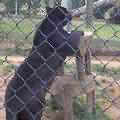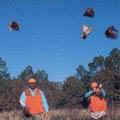|
作者:傑奇•艾倫•朱利安諾 博士
在美國,這樣的行為幾乎是每天不斷地重覆發生。但是,這些貪婪而無人性的獵場老板,究竟是從哪裡得來這些動物的?
您將會為所得到的答案震驚,特別是如果您曾經帶孩子去動物園看他們所喜愛的動物。
在美國約有2,500個持有執照的動物展示場,且有許多豢養的動物都會繁殖。有些統計指出,若包括沒有執照場所,則約有1萬5千個動物展示場。此外,許多動物園都有成功的繁殖計畫,社會大眾也捐款支持動物園,進行繁殖稀有的、甚至是瀕臨絕種的動物。
然而大眾並不知道,動物園往往沒有足夠個空間及資源,去照料這些成功繁殖出來的動物。

在加拿大新斯科舍省,橡園農場動物園中的一隻黑豹。(照片版權歸屬
奧克蘭農場動物園)
還有,您可能認為這些計畫所繁殖的動物,應該會回歸自然,來增加這些物種的數量。不幸的是,大部分的時候,動物園沒有經費可以實行那些高尚的目標,因此造成園內的動物數量過剩。同時動物園也讓那些非屬瀕臨絕種的野生動物物種進行繁殖,造成長頸鹿、猴子與犀牛的數量,超過動物園所能收容與餵養的限度。
新加坡動物園便直接承認,就算是那些飼養在籠內的瀕臨絕種動物,牠們被野放的機會也都不大。新加坡動物園網站上的官方聲明寫道:「有許多原因使得這些在封閉環境下繁殖出來的瀕臨絕種動物,不適合野放,但可以與其他動物園做交換。」他們聲稱,這麼做可以減少動物園對真正野生動物的需求數目。
一些有合法登記且知名的動物園會把過剩的動物賣給掮客(交易仲介商)。就算動物園本身即為反對獸欄狩獵團體「美國動物園與水族館協會」的成員,園方也不去追問掮客究竟會把動物賣到哪裡去。許多動物最後都成了獸欄狩獵活動中的獵物。
更不用說那數量眾多的寵物園、非正規的動物園、或小型展示館,他們更沒有義務或是權責方面的壓力,去遵守任何規則或指導方針。
「人道協會」的報告指出,德州的聖安東尼奧動物園公開販售園內的動物,而在該動物園的董事會成員當中,甚至有人是獵場的擁有者。在1994年,該協會曾有報導指出,聖安東尼奧動物園董事會成員貝蒂•凱斯洛跟她的丈夫羅柏特,擁有德州的奧漢獵場(Auerhahn Ranch),他們直接向動物園購買外來種動物達數年之久。
醫生、律師以及其他各行各業的人士,離開他們位在郊區的住家,來此度過週末的殺戮饗宴,索價高昂的利益遊說者就在這些狩獵區裡取悅著政客。「野生動物保護網」表示:「獸欄狩獵區已開始變得像高爾夫球場一樣,成了施弄政商手腕的最佳場所。」其報告指出,美國前總統喬治•布希1988年的選舉慶功宴,便是在德州比威爾附近的Lazy F農場裡舉行的。

位於喬治亞州的鵪鶉獵場(照片版權歸屬
河景農場)
對於人們批評這每年一次狩獵活動,布希不久後便回應說:『這些不是動物,他們是野生鵪鶉。』很顯然的,布希先生從未唸過生物,且對何謂「野生」,有著不尋常的定義。他所射殺的鳥,是被囚禁在籠裡的鳥,由人類餵養長大。
【全文連載】
■最低等的生物 (上) (中) (下)
全文與圖片詳見: http://ens.lycos.com/ens/mar2002/2002L-03-22g.html
版權歸屬Environment News Service(ENS),環境資訊協會(徐怡德 譯,蘇崧棱、蔡麗伶 審校)
|
|
By Jackie Alan Giuliano, Ph.D
Acts like this are repeated every day around the nation. But where are these greedy, soulless preserve owners getting these animals?
You will be shocked and surprised at the answer, especially if you have taken your children to the local zoo to see their favorite beloved animal.
There are 2,500 licensed animal exhibitors in the U.S. and many of the animals in captivity will breed. Some estimates say that when you count the unlicensed ones, there are over 15,000 animal exhibitors. Also, many zoos have successful breeding programs that get public donations to support their efforts to repopulate depleted, even endangered species.
Well, what the public doesn’t hear about is that when these breeding programs are successful, they often result in more animals than the zoo can care for with limited space and resources.

Black leopard in Oaklawn Farm Zoo, Aylesford, Nova Scotia (Photo courtesy
Oaklawn Farm
Zoo)
But wait a minute! You probably thought that the resulting animals from these programs would be returned to the wild to repopulate the species. Unfortunately, often money does not exist to carry out those lofty aims and the animals become surplus. Animals that are not endangered in the wild will breed as well, resulting in more giraffes, monkeys, and rhinos than zoos can house and feed.
The Singapore Zoo freely admits that even endangered species bred in captivity have little chance of being returned to the wild. At the zoo's website, officials state, “While for many reasons, it may not be possible to reintroduce most captive-bred endangered animals into the wild, such animals can be used in exchange programmes among zoos.” They claim that this results in fewer animals having to be taken from the wild.
Legitimate, well known zoos sell surplus animals to brokers. Even zoos that are members of the American Zoo and Aquarium Association, which condemns canned hunts, will not ask their brokers where they intend to sell the animals. Many wind up in canned hunts.
The thousands of petting zoos, roadside zoos, and smaller exhibitors have no reason to adhere to any rules or guidelines.
The Humane Society reports that the San Antonio Zoo in Texas sold its animals openly and even included owners of canned hunting facilities on the zoo's board of directors. In 1994, HSUS reported that San Antonio Zoological Society board member Betty Kelso and her husband Robert owned the Auerhahn Ranch in Texas and purchased exotic animals directly from the zoo for years.
Doctors, lawyers and professionals from all walks of life leave the suburbs for a weekend killing spree, and high priced lobbyists entertain politicians on shooting preserves. The Wildlife Protection Network says, “Canned hunting preserves have begun to rival golf courses as favorite landscapes [for] wheeling and dealing.” They report that former President George Bush celebrated his victory after the 1988 presidential election at the Lazy F Ranch near Beeville, Texas.

Quail hunting in Georgia (Photo courtesy Riverview
Plantation)
"These aren't animals, these are wild quail," he later said to criticism of his yearly hunt. Bush apparently never studied biology, and has an odd definition of "wild." The birds he shot were captive birds that were hand fed and raised in pens.
http://ens.lycos.com/ens/mar2002/2002L-03-22g.html |
